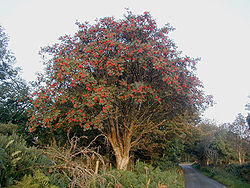Definition of native
Native species are considered to be species which are today present in the region in question, and have been continuously present in that region since a certain period of time. When applied to Britain and Ireland, three possible definitions of this time constraint are:
- a species that colonised these islands during the retreat of ice at the end of the last ice age
- a species that was present in these islands when the English Channel was created and the land bridge between Britain and continental Europe was flooded
- a species that has colonised without human assistance; in some cases this is uncertain.
The only endemic tree species in Britain and Ireland (that is, that are native only to this region) are some apomictic whitebeams.
Species that were native in the region in prehistory before the last ice age, but not subsequently, are generally regarded as extinct and no longer native.
Many additional species have been imported by humans; the total list of all introduced trees numbers several thousand. A far smaller number of these have become widely naturalised, spreading by their own accord without recourse to further human assistance.



